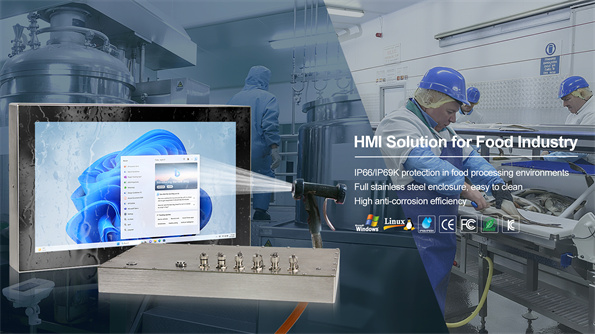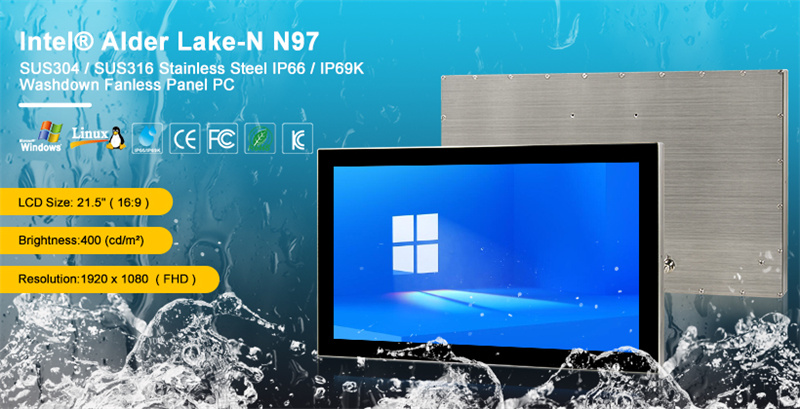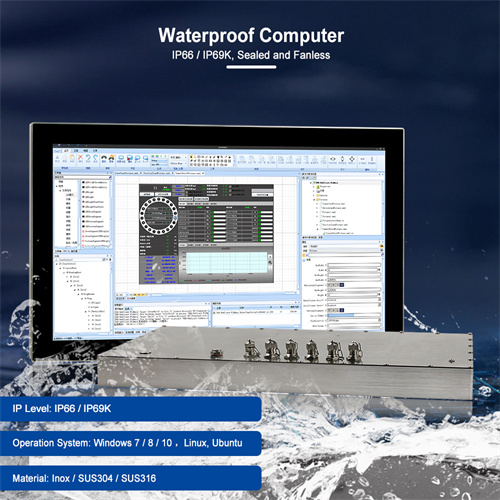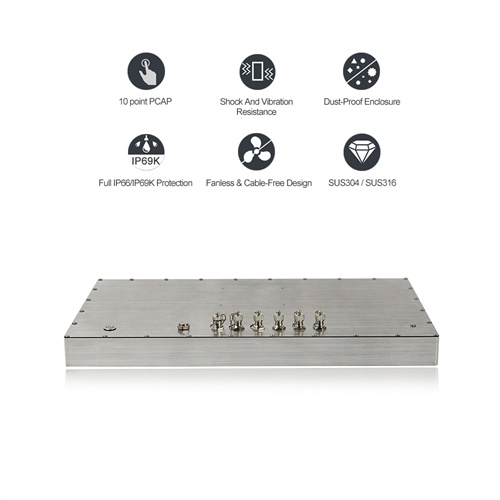How to Select a Waterproof Industrial Computer for Food Processing: Key Features, IP Ratings, and Hygiene Standards

IP Ratings, Hygiene Compliance, and Key Design Considerations
In food processing environments, where equipment is constantly exposed to water, steam, and aggressive cleaning agents, selecting the right waterproof industrial computer is crucial. These systems must do more than resist moisture—they must also meet stringent hygiene standards and withstand harsh industrial conditions. This guide outlines the essential criteria for choosing a reliable solution for such demanding settings.
The Need for Waterproof Industrial Computers in Food Processing
Food processing operations involve continuous cleaning, exposure to liquids, and contact with food particles. Computers used in these areas must remain functional despite repeated washdowns, condensation, and the presence of sanitizing chemicals. Standard commercial computers are not designed for such use and are likely to fail quickly.
Waterproof industrial computers, on the other hand, are engineered to operate reliably in wet and hygienically sensitive environments. Their sealed enclosures prevent contamination and system damage, helping businesses meet hygiene standards and reduce unplanned downtime.
IP Ratings: What They Mean and Why They Matter
The Ingress Protection (IP) rating system is used to define the sealing effectiveness of electrical enclosures against dust and liquids. Understanding IP ratings is essential when evaluating waterproof computers.
An IP rating includes two numbers. The first digit indicates protection against solid particles, such as dust, while the second digit refers to protection against water ingress.
For example, an IP66-rated computer is completely dust-tight and can withstand powerful water jets from any direction. If the equipment is exposed to immersion or high-pressure cleaning, a higher rating such as IP67 or IP69K should be considered.
IP69K is particularly suitable for food environments requiring high-temperature, high-pressure washdowns, as it ensures the system will remain sealed and fully functional after sanitation routines.
Key Design Features for Food-Safe Waterproof Computers

In addition to water and dust protection, several design elements contribute to a computer’s suitability for food processing applications.
A fanless, sealed design is fundamental. By eliminating airflow, the system reduces the risk of drawing in airborne contaminants. The sealed housing also prevents moisture from entering and damaging internal components.
Touchscreen functionality should remain reliable even when the surface is wet or when operators wear gloves. This ensures usability during active processing or cleaning procedures. The screen surface must also tolerate frequent exposure to cleaning chemicals without degradation.
Material selection is another critical factor. Stainless steel, particularly 304 or 316 grade, is widely used for food-grade equipment. It resists corrosion, is easy to clean, and supports compliance with regulatory hygiene standards. Some systems may also include antimicrobial coatings to reduce microbial growth on surfaces.
Meeting Hygiene and Safety Standards

Regulatory compliance is non-negotiable in food production. Equipment used in food zones must support strict hygiene protocols and be easy to sanitize.
Computers should comply with guidelines set by organizations such as the FDA or NSF. This means the external design must allow thorough cleaning and be resistant to both corrosion and chemical damage. Enclosures should have smooth surfaces without crevices, minimizing places where bacteria could accumulate.
Using computers that meet these requirements not only protects food safety but also helps prevent costly recalls or shutdowns.
Interface Considerations for Wet Environments
In wet or sanitized environments, user interaction can be challenging. Touch interfaces must function accurately in the presence of water and be responsive to gloved touch. This ensures operators can control systems without compromising on hygiene or efficiency.
The screen should also be chemically resistant to withstand alcohol-based disinfectants and alkaline or acidic cleaning agents typically used in food processing facilities. Long-term durability under such conditions is essential to avoid display wear or failure.
Performance, Connectivity, and Maintenance
While environmental protection is key, performance should not be overlooked. The selected computer must deliver sufficient processing power and memory capacity to support the intended applications, such as machine control, data logging, or real-time visualization.
Connectivity options are equally important. Look for systems that offer flexible interfaces, including Ethernet, serial ports, USB, and wireless communication, to integrate smoothly with existing networks and automation systems.
Maintenance routines should be simple and clearly defined. The design should support fast cleaning and minimize the need for manual servicing. Choosing a system with long product life cycles and technical support services also contributes to reduced downtime and total cost of ownership.
Making the Right Choice: A Practical Checklist
When selecting a water resistant computer for food processing environments, consider the following criteria:
- • Ensure the IP rating matches the required level of water and dust protection.
- • Verify compliance with food industry hygiene standards.
- • Choose materials like stainless steel that resist corrosion and are easy to clean.
- • Confirm touch interface usability under wet and gloved conditions.
- • Evaluate processing capabilities and available connectivity options.
- • Factor in ease of maintenance and vendor support.

Ensuring Safety and Operational Efficiency
Choosing a waterproof panel PC tailored to the needs of food processing is a strategic decision. The right solution enhances safety, maintains hygiene, and ensures reliable system operation even under constant exposure to water, steam, and chemicals.
By focusing on the appropriate IP rating, hygienic design, and environmental durability, manufacturers can reduce equipment failures and streamline operations. Ultimately, investing in the right industrial computer protects product quality, supports regulatory compliance, and delivers long-term performance in demanding conditions.
